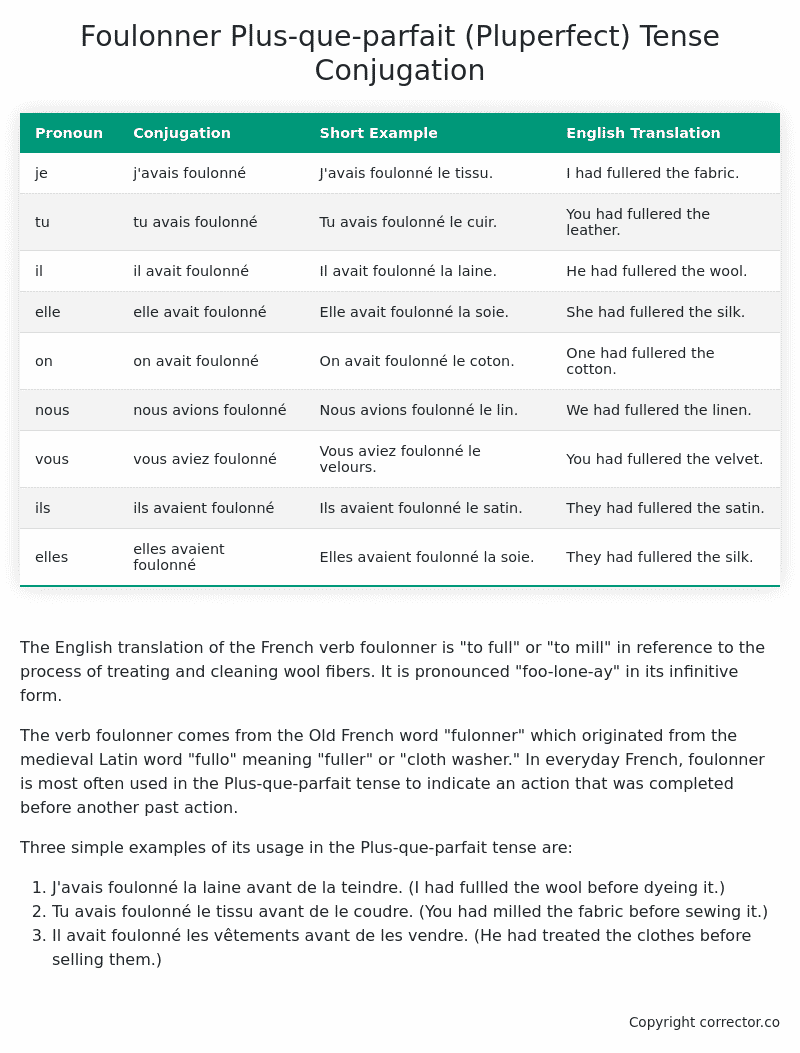Plus-que-parfait (Pluperfect) Tense Conjugation of the French Verb foulonner
Introduction to the verb foulonner
The English translation of the French verb foulonner is “to full” or “to mill” in reference to the process of treating and cleaning wool fibers. It is pronounced “foo-lone-ay” in its infinitive form.
The verb foulonner comes from the Old French word “fulonner” which originated from the medieval Latin word “fullo” meaning “fuller” or “cloth washer.” In everyday French, foulonner is most often used in the Plus-que-parfait tense to indicate an action that was completed before another past action.
Three simple examples of its usage in the Plus-que-parfait tense are:
- J’avais foulonné la laine avant de la teindre. (I had fullled the wool before dyeing it.)
- Tu avais foulonné le tissu avant de le coudre. (You had milled the fabric before sewing it.)
- Il avait foulonné les vêtements avant de les vendre. (He had treated the clothes before selling them.)
Table of the Plus-que-parfait (Pluperfect) Tense Conjugation of foulonner
| Pronoun | Conjugation | Short Example | English Translation |
|---|---|---|---|
| je | j’avais foulonné | J’avais foulonné le tissu. | I had fullered the fabric. |
| tu | tu avais foulonné | Tu avais foulonné le cuir. | You had fullered the leather. |
| il | il avait foulonné | Il avait foulonné la laine. | He had fullered the wool. |
| elle | elle avait foulonné | Elle avait foulonné la soie. | She had fullered the silk. |
| on | on avait foulonné | On avait foulonné le coton. | One had fullered the cotton. |
| nous | nous avions foulonné | Nous avions foulonné le lin. | We had fullered the linen. |
| vous | vous aviez foulonné | Vous aviez foulonné le velours. | You had fullered the velvet. |
| ils | ils avaient foulonné | Ils avaient foulonné le satin. | They had fullered the satin. |
| elles | elles avaient foulonné | Elles avaient foulonné la soie. | They had fullered the silk. |
Other Conjugations for Foulonner.
Le Present (Present Tense) Conjugation of the French Verb foulonner
Imparfait (Imperfect) Tense Conjugation of the French Verb foulonner
Passé Simple (Simple Past) Tense Conjugation of the French Verb foulonner
Passé Composé (Present Perfect) Tense Conjugation of the French Verb foulonner
Futur Simple (Simple Future) Tense Conjugation of the French Verb foulonner
Futur Proche (Near Future) Tense Conjugation of the French Verb foulonner
Plus-que-parfait (Pluperfect) Tense Conjugation of the French Verb foulonner (this article)
Passé Antérieur (Past Anterior) Tense Conjugation of the French Verb foulonner
Futur Antérieur (Future Anterior) Tense Conjugation of the French Verb foulonner
Subjonctif Présent (Subjunctive Present) Tense Conjugation of the French Verb foulonner
Subjonctif Passé (Subjunctive Past) Tense Conjugation of the French Verb foulonner
Subjonctif Imparfait (Subjunctive Imperfect) Tense Conjugation of the French Verb foulonner
Subjonctif Plus-que-parfait (Subjunctive Pluperfect) Tense Conjugation of the French Verb foulonner
Conditionnel Présent (Conditional Present) Tense Conjugation of the French Verb foulonner
Conditionnel Passé (Conditional Past) Tense Conjugation of the French Verb foulonner
L’impératif Présent (Imperative Present) Tense Conjugation of the French Verb foulonner
L’infinitif Présent (Infinitive Present) Tense Conjugation of the French Verb foulonner
Struggling with French verbs or the language in general? Why not use our free French Grammar Checker – no registration required!
Get a FREE Download Study Sheet of this Conjugation 🔥
Simply right click the image below, click “save image” and get your free reference for the foulonner Plus-que-parfait tense conjugation!

Foulonner – About the French Plus-que-parfait (Pluperfect) Tense
Tense Formation
Common everyday usage patterns
Sequencing of past events
Background information
Hypothetical or reported speech
Interactions with other tenses
Summary
I hope you enjoyed this article on the verb foulonner. Still in a learning mood? Check out another TOTALLY random French verb conjugation!


